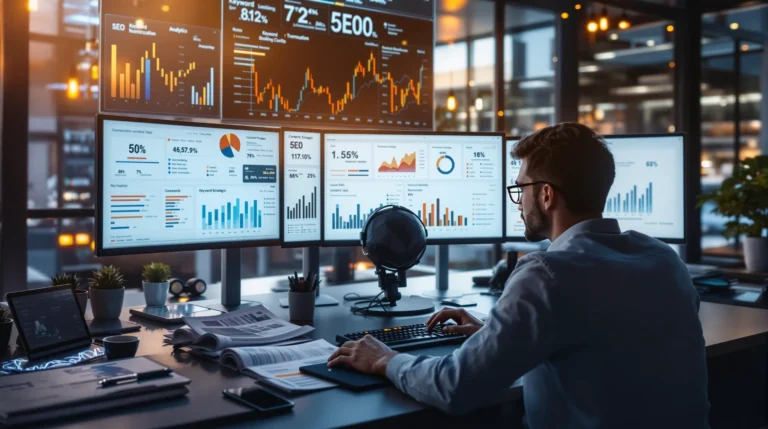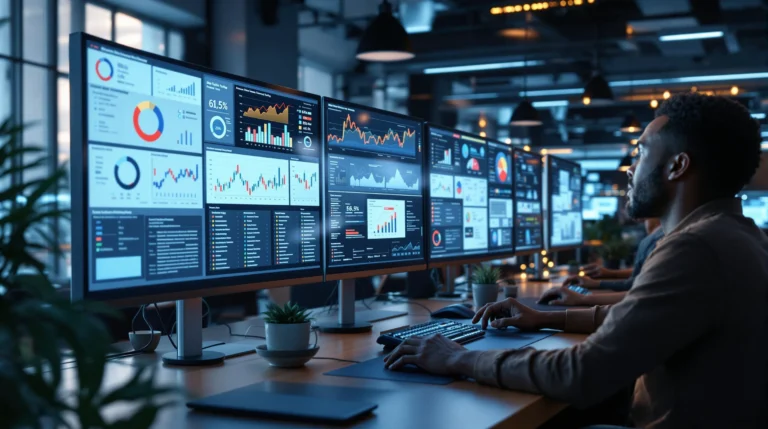Master How to Optimize Your Content for Better Rankings
Learning how to optimize your content effectively can transform your online presence and drive meaningful traffic to your website. Content optimization combines strategic keyword placement, user experience enhancements, and technical improvements to help your material rank higher in search engine results. When you optimize your content properly, you create resources that both search engines and human readers appreciate, leading to increased visibility and better engagement rates.
At Superlewis Solutions, we understand the intricacies of content optimization and help businesses across North America achieve their online marketing goals. Our team combines decades of experience with cutting-edge AI tools to create content that not only ranks well but also converts visitors into customers. If you’re ready to take your content strategy to the next level, contact us at +1 (800) 343-1604 or through our contact form to discuss how we can help optimize your content for maximum impact.
The Evolution of Content Optimization
Content optimization has undergone significant changes over the past two decades, evolving from simple keyword stuffing techniques to sophisticated strategies that prioritize user intent and experience. In the early days of search engine optimization, many marketers focused solely on keyword density and meta tags, often at the expense of readability and user value. However, search engines have become increasingly sophisticated in their ability to understand context, semantics, and user behavior patterns.
Modern content optimization requires a holistic approach that considers multiple factors simultaneously. Search algorithms now evaluate content quality based on engagement metrics, topical authority, and how well the material satisfies user search intent. This shift has made content optimization more complex but also more rewarding for businesses willing to invest in quality strategies.
The integration of artificial intelligence and machine learning into search algorithms has further refined how content is evaluated and ranked. Search engines can now better understand natural language patterns, context clues, and the relationships between different pieces of content on a website. This technological advancement means that successful content optimization strategies must account for semantic relationships and topical clustering rather than focusing solely on individual keywords.
Understanding Search Intent and User Behavior
Successful content optimization begins with a deep understanding of search intent and user behavior patterns. When people search for information online, they typically fall into one of four main categories: informational, navigational, transactional, or commercial investigation. Each type of search intent requires a different approach to content structure, tone, and call-to-action placement.
Informational searches represent users seeking knowledge or answers to specific questions. These searchers benefit from comprehensive, well-structured content that addresses their queries thoroughly while providing additional context and related information. Content targeting informational intent should focus on education and value delivery rather than direct sales messaging.
Transactional searches indicate users ready to make a purchase or take a specific action. Content optimized for transactional intent should include clear product descriptions, benefit statements, and streamlined conversion paths. The optimization strategy for this content type emphasizes trust signals, social proof, and removing barriers to conversion.
Commercial investigation searches represent users comparing options before making decisions. This audience requires content that addresses concerns, provides comparisons, and builds confidence in potential solutions. Optimization for commercial investigation content should balance informative elements with persuasive messaging that guides users toward favorable decisions.
Technical Foundations for Content Enhancement
The technical aspects of content optimization form the foundation upon which all other strategies build. Page loading speed directly impacts both user experience and search engine rankings, making it a priority consideration for any optimization effort. Content that loads slowly frustrates users and signals quality issues to search algorithms, regardless of how well-written or informative the material might be.
Mobile responsiveness has become non-negotiable in content optimization strategies. With mobile devices accounting for the majority of web traffic, content must display properly and function seamlessly across different screen sizes and device types. This requirement extends beyond simple responsive design to include considerations for touch navigation, readable font sizes, and appropriate spacing between interactive elements.
Structured data markup provides search engines with additional context about your content, helping them understand and display your material more effectively in search results. Proper implementation of schema markup can lead to enhanced search result features such as rich snippets, knowledge panels, and other prominent display options that increase click-through rates.
Internal linking structure plays a vital role in content optimization by distributing page authority throughout your website and helping search engines understand the relationships between different pieces of content. Strategic internal linking also improves user navigation and keeps visitors engaged with your material for longer periods.
Content Structure and Readability Optimization
Effective content structure serves both human readers and search engine crawlers, making it easier for both to understand and process your material. Well-organized content uses hierarchical heading structures that create logical flow and make information easily scannable. This approach helps users quickly find the information they seek while providing search engines with clear signals about content organization and topic coverage.
Readability optimization involves adjusting sentence length, vocabulary complexity, and paragraph structure to match your target audience’s reading level and preferences. Content that is easy to read and understand typically generates better engagement metrics, which can positively impact search rankings. Consider factors such as average sentence length, use of transition words, and the balance between complex and simple vocabulary when refining your content.
Visual elements such as images, videos, and infographics can significantly enhance content optimization efforts when implemented strategically. These elements break up text-heavy sections, provide additional context, and can help explain complex concepts more effectively. However, visual content must be optimized with appropriate file sizes, descriptive alt text, and relevant captions to maximize their SEO benefits.
Keyword Integration and Semantic Optimization
Modern keyword integration goes far beyond simply inserting target terms into your content at predetermined intervals. Successful optimization strategies focus on natural language patterns and semantic relationships that help search engines understand the full context and meaning of your material. This approach requires understanding related terms, synonyms, and concepts that support your primary topics.
Semantic optimization involves creating content that covers topics comprehensively rather than focusing narrowly on specific keyword phrases. This strategy helps establish topical authority and provides more value to readers while satisfying search engine requirements for thorough topic coverage. Consider the questions your audience might have and the related concepts they need to understand when developing your content strategy.
Long-tail keyword integration provides opportunities to capture more specific search queries while facing less competition than broader terms. These phrases often indicate higher user intent and can drive more qualified traffic to your content. When you optimize your content for long-tail keywords, focus on natural integration that maintains readability and provides genuine value to your audience.
Content Optimization Comparison Table
| Optimization Aspect | Traditional Approach | Modern Strategy | Key Benefits |
|---|---|---|---|
| Keyword Usage | High density focus | Natural semantic integration | Better user experience and rankings |
| Content Length | Minimum word counts | Comprehensive topic coverage | Enhanced topical authority |
| Technical Elements | Basic meta tags | Structured data and core web vitals | Improved search visibility |
| User Experience | Secondary consideration | Primary optimization factor | Higher engagement and conversions |
| Content Updates | Set and forget | Regular refresh and optimization | Sustained performance improvement |
How Superlewis Solutions Transforms Content Performance
At Superlewis Solutions, we take a comprehensive approach to help businesses optimize your content for maximum search visibility and conversion potential. Our team combines over two decades of online marketing experience with advanced AI tools to create content strategies that deliver measurable results. We understand that effective content optimization requires balancing search engine requirements with user needs and business objectives.
Our content creation services focus on developing material that naturally incorporates optimization best practices while maintaining readability and engagement. We begin each project with thorough keyword research and competitive analysis to identify opportunities for improved rankings and traffic growth. This foundation ensures that every piece of content we create serves both optimization goals and user intent.
The integration of AI technology into our content optimization process allows us to analyze semantic relationships, identify content gaps, and predict performance potential before publication. This technological advantage helps us create more effective content strategies while reducing the time required to achieve results. Our clients benefit from cutting-edge optimization techniques that many competitors have yet to adopt.
We provide ongoing monitoring and performance tracking to ensure that optimized content continues to perform well over time. Search algorithms and user behavior patterns change regularly, requiring adjustments to maintain and improve rankings. Our team proactively identifies optimization opportunities and implements updates to keep your content competitive in search results.
Our approach to content optimization extends beyond individual pages to encompass your entire content ecosystem. We develop internal linking strategies, create topic clusters, and ensure that all content works together to establish topical authority in your industry. This comprehensive strategy provides better long-term results than focusing on individual pieces of content in isolation.
Advanced Optimization Strategies and Future Trends
Advanced content optimization strategies incorporate emerging technologies and changing user behaviors to stay ahead of competitive pressures. Voice search optimization has become increasingly important as more users rely on voice assistants to find information online. Content optimized for voice search typically uses more natural language patterns and addresses specific questions that users might ask verbally.
Artificial intelligence and machine learning technologies are reshaping how content optimization strategies are developed and implemented. These tools can analyze vast amounts of data to identify patterns and opportunities that human analysis might miss. AI-powered optimization can help predict which content modifications will have the greatest impact on performance metrics.
User experience signals continue to gain importance in search ranking algorithms, making optimization strategies that prioritize user satisfaction increasingly valuable. Metrics such as time on page, bounce rate, and user engagement patterns provide search engines with insights into content quality and relevance. Future optimization strategies will likely place even greater emphasis on these user-centric factors.
Content personalization represents an emerging frontier in optimization strategies, allowing businesses to tailor their material to specific audience segments or individual user preferences. This approach can improve engagement metrics and conversion rates while providing search engines with positive user behavior signals that support higher rankings.
The integration of multimedia elements and interactive features into content optimization strategies offers opportunities to enhance user engagement and provide more comprehensive topic coverage. However, these elements must be implemented thoughtfully to avoid negatively impacting page loading speeds or mobile user experience.
Practical Implementation and Measurement Strategies
Implementing effective content optimization requires a systematic approach that balances immediate improvements with long-term strategic goals. Begin by conducting a comprehensive audit of your existing content to identify optimization opportunities and performance gaps. This analysis should include technical factors, content quality assessment, and competitive comparison to establish baseline metrics and priority areas for improvement.
Develop a content calendar that incorporates optimization activities alongside new content creation. Regular content updates and refreshes can help maintain and improve search rankings while providing opportunities to incorporate new keywords and address evolving user needs. Schedule these activities based on content performance data and seasonal trends relevant to your industry.
Establish clear measurement criteria to track the effectiveness of your optimization efforts. Monitor metrics such as organic traffic growth, keyword ranking improvements, user engagement indicators, and conversion rate changes to assess the impact of your strategies. Use tools like SEMrush and Ahrefs to gather comprehensive performance data and identify new optimization opportunities.
Create documentation processes that capture successful optimization techniques and results for future reference. This knowledge base will help you replicate successful strategies across different content pieces and identify patterns that contribute to improved performance. Regular analysis of this data can reveal insights that inform broader content strategy decisions.
Consider the broader context of your optimization efforts within your overall marketing strategy. Content optimization should support your business objectives and integrate seamlessly with other marketing channels such as social media, email marketing, and paid advertising campaigns. This integrated approach maximizes the return on your optimization investments.
Conclusion
Content optimization represents a fundamental component of successful online marketing strategies, requiring careful attention to both technical requirements and user experience factors. When you optimize your content effectively, you create valuable resources that attract targeted traffic, engage your audience, and support your business objectives. The strategies and techniques discussed throughout this article provide a foundation for developing optimization approaches that deliver measurable results.
The landscape of content optimization continues changing as search algorithms become more sophisticated and user expectations increase. Staying current with best practices and emerging trends ensures that your optimization efforts remain effective over time. Success in content optimization requires ongoing commitment to quality, user value, and strategic implementation of proven techniques.
How will you integrate these optimization strategies into your current content marketing efforts? What specific challenges does your business face in creating content that ranks well and converts effectively? Are you ready to take advantage of advanced optimization techniques that can set your content apart from competitors?
Ready to transform your content performance with professional optimization strategies? Contact Superlewis Solutions today at +1 (800) 343-1604 or visit our SEO marketing services page to learn how our experienced team can help you achieve better rankings, increased traffic, and improved conversions through strategic content optimization.






